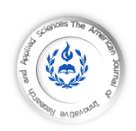
GENERAL INFORMATION

| ISSN: 2429-5396 (e) | www.american-jiras.com | |
| Web Site Form: v 0.1.05 | JF 22 Cours, Wellington le Clairval, Lillebonne | France |
| Web Site Form: v 0.1.05 | JF 22 Cours, Wellington le Clairval, Lillebonne | France |

ResearchBib, Google Scholar, SIS database, i.f.s.i.j, Scribd, IISJ, Eurasian Scientific Journal Index (ESJI), Indianscience.in, arastirmax, Directory of Research Journals Indexing, Pak Academic Sesearch, AcademicKeays, CiteSeerX, UDL Library, CAS Abstracts, J-Gate, WorldCat, Scirus, IET Inspec Direct, and getCited
Indexed by:
| HOME | ABOUT US | ARCHIVE | AIMS AND SCOP | AUTHORS | REVIEW | SUMIBMIT MANUSCRIPT | EDITORIAL BOARED | PUBLICATION FEE |
| | ARTICLES | Am. J. innov. res. appl. sci. Volume 11, Issue 1, Pages 68-73 (July 2020) |
| Research Article |


|
American Journal of innovative
Research & Applied Sciences
Research & Applied Sciences
ISSN 2429-5396 (Online)
OCLC Number: 920041286
OCLC Number: 920041286
| HOME || ABOUT US || ARCHIVES || AIMS AND SCOP || AUTHORS || REVIEW|| SUBMIT MANUSCRIPT || EDITORIAL BOARD || CONTACT US |

| JUJY | VOLUME 11 | N° 1 | 2020 |

| Info-AJIRAS-® Journal ISSN 2429-5396 (Online) / Reference CIF/15/0289M |
American Journal of Innovative Research & Applied Sciences
Authors Contact
*Correspondant author and authors Copyright © 2020:
| Victor Kubali Mwisa 1| Promesse Muhubao Bahati 1 |Enock Kakumbi Katondo 3 |Jean Pierre Bajope Baluku4 |
Josué Mateso Mupenda 1| Antoine Aksanti Lwango 2 | Jean Pierre Kiyombo Mbela 8 |Faustin Walemba Walelama
5 | Fréderic Papy Lwango Ntamulume 7 | and |Crispin Sadiki Lurhuma 6 |
Affiliation
1. Institut Supérieur des Techniques Médicales de Shabunda | RD Congo |
2.Institut Supérieur des Techniques Médicales de Bukavu | DR Congo|
3.Institut Supérieur Agro vétérinaire et Gestion de l’Environnement/Kahuzi Biega | Bunyakiri | RD Congo |
4.Centre de Recherche en Sciences Naturelles de Lwiro | RD Congo |
5.Institut Supérieur des Développements Rural | Shabunda | RD Congo |
6.Agence d’Achat de Performances de Bukavu (AAP) | RD Congo |
7.Coordonnateur de programme de sécurité alimentaire NRC Tanganyika | RD Congo |
8.Université de kinshasa | Ecole de Santé Publique | RD Congo |
This article is made freely available as part of this journal's Open Access: ID | Kubali-Ref.1-ajira130720 |
RESUME
Objectif : Contribuer à l’amélioration de l’environnement hospitalier par la gestion rationnelle des déchets biomédicaux (DBM) à l’ l’Hôpital Provincial Général de Référence de Bukavu (HPGR) Bukavu. Méthodes : Notre étude est transversale faite du 24 mars au 26 septembre 2015 adressé à 79 prestataires des soins inclut les ouvriers chargés de l’hygiène hospitalière a été utilisé. La collecte des données est faite par questionnaire d’enquête, des observations directes en passant d’un service à un autre nous ont aidés à compléter et affirmer les données quantitatives. L’analyse des données est faite par Epi-info 3.5.1 et logiciel Excel, test ANOVA/test-Z. Résultats : Après nos investigations sur le terrain nous avons abouti aux résultats selon lesquels : La quantité estimée en moyenne de déchet Biomédicaux produite par jour est de 126 kg dans l’ensemble, repartit en 8,4 kg par département et 0,36 kg par lit. Prêt de la totalité de répondants aux connaissances élevées en matière de gestion de DBM (91%). La stratégie d’amélioration du système de Gestion de déchets biomédicaux à l’Hôpital Provincial Général de Référence de Bukavu était nulle. Conclusion : La gestion des déchets biomédicaux est un problème réel dans l’HPGR La formation continue et la sensibilisation du personnel sont parmi les stratégies à mettre en place pour une gestion rationnelle des déchets biomédicaux dans cette structure.
Mots clés : Gestion rationnelle– Déchets Biomédicaux – Hôpital Provincial – Bukavu.
ABSTRACT
Objective: To contribute to the achievement of the hospital environment throughout national use of biomedical waste (BW) at the the Bukavu Provincial General Reference Hospital (HPGR) Bukavu. Methods: Our cross-sectional study from March 24 to September 26, 2015, addressed to 79 healthcare providers including workers in charge of hospital hygiene was used. Data collection is done by survey questionnaire, direct observations from one department to another helped us to complete and affirm the quantitative data. Data analysis is done by Epi-info 3.5.1 and Excel software, ANOVA test / test-Z. Results: After our investigation in the place, the following results were given/found: The number of insalibrity produced by people around the earth by day was 126 kg in general, but divided in 8.4 kg in the department and finaly 0,38 kg for a liter. The number of people, who were ready to answer to the knowled of management of biomedical waste (MBW) (91%). The strategy to improve the management of BW at the general hospital of Bukavu was that thousand. Conclusion: The use of MBW is a real problem in the general hospital of Bukavu, we continue the formation in order to inform people concerning this matter, the fact of informing people about the case is one among our strategies even for those of Biomedical leaders concerning the structure of insalubrity.
Keywords: Management - Biomedical Waste - Provincial Hospital – Bukavu.
Objectif : Contribuer à l’amélioration de l’environnement hospitalier par la gestion rationnelle des déchets biomédicaux (DBM) à l’ l’Hôpital Provincial Général de Référence de Bukavu (HPGR) Bukavu. Méthodes : Notre étude est transversale faite du 24 mars au 26 septembre 2015 adressé à 79 prestataires des soins inclut les ouvriers chargés de l’hygiène hospitalière a été utilisé. La collecte des données est faite par questionnaire d’enquête, des observations directes en passant d’un service à un autre nous ont aidés à compléter et affirmer les données quantitatives. L’analyse des données est faite par Epi-info 3.5.1 et logiciel Excel, test ANOVA/test-Z. Résultats : Après nos investigations sur le terrain nous avons abouti aux résultats selon lesquels : La quantité estimée en moyenne de déchet Biomédicaux produite par jour est de 126 kg dans l’ensemble, repartit en 8,4 kg par département et 0,36 kg par lit. Prêt de la totalité de répondants aux connaissances élevées en matière de gestion de DBM (91%). La stratégie d’amélioration du système de Gestion de déchets biomédicaux à l’Hôpital Provincial Général de Référence de Bukavu était nulle. Conclusion : La gestion des déchets biomédicaux est un problème réel dans l’HPGR La formation continue et la sensibilisation du personnel sont parmi les stratégies à mettre en place pour une gestion rationnelle des déchets biomédicaux dans cette structure.
Mots clés : Gestion rationnelle– Déchets Biomédicaux – Hôpital Provincial – Bukavu.
ABSTRACT
Objective: To contribute to the achievement of the hospital environment throughout national use of biomedical waste (BW) at the the Bukavu Provincial General Reference Hospital (HPGR) Bukavu. Methods: Our cross-sectional study from March 24 to September 26, 2015, addressed to 79 healthcare providers including workers in charge of hospital hygiene was used. Data collection is done by survey questionnaire, direct observations from one department to another helped us to complete and affirm the quantitative data. Data analysis is done by Epi-info 3.5.1 and Excel software, ANOVA test / test-Z. Results: After our investigation in the place, the following results were given/found: The number of insalibrity produced by people around the earth by day was 126 kg in general, but divided in 8.4 kg in the department and finaly 0,38 kg for a liter. The number of people, who were ready to answer to the knowled of management of biomedical waste (MBW) (91%). The strategy to improve the management of BW at the general hospital of Bukavu was that thousand. Conclusion: The use of MBW is a real problem in the general hospital of Bukavu, we continue the formation in order to inform people concerning this matter, the fact of informing people about the case is one among our strategies even for those of Biomedical leaders concerning the structure of insalubrity.
Keywords: Management - Biomedical Waste - Provincial Hospital – Bukavu.
GESTION DES DECHETS BIOMEDICAUX A L’HOPITAL PROVINCIAL GENERAL DE REFERENCE DE BUKAVU
MANAGEMENT OF BIOMEDICAL WASTE AT THE GENERAL PROVINCIAL REFERENCE HOSPITAL OF BUKAVU
| Victor Kubali Mwisa 1 | Promesse Muhubao Bahati 1 | Enock Kakumbi Katondo3 |Jean Pierre Bajope Baluku 4 | Josué Mateso Mupenda 1 | Antoine Aksanti Lwango 2 | Jean Pierre Kiyombo Mbela 8 | Faustin Walemba Walelama 5 | Fréderic Papy Lwango Ntamulume 7 | and |Crispin Sadiki Lurhuma 6 |. Am. J. innov. res. appl. sci. 2020; 11(1):67-73.
| PDF FULL TEXT | | XML FILE | | Received | June 13, 2020 | | Accepted | July 15, 2020 | | Published | August 27, 2020 |
MANAGEMENT OF BIOMEDICAL WASTE AT THE GENERAL PROVINCIAL REFERENCE HOSPITAL OF BUKAVU
| Victor Kubali Mwisa 1 | Promesse Muhubao Bahati 1 | Enock Kakumbi Katondo3 |Jean Pierre Bajope Baluku 4 | Josué Mateso Mupenda 1 | Antoine Aksanti Lwango 2 | Jean Pierre Kiyombo Mbela 8 | Faustin Walemba Walelama 5 | Fréderic Papy Lwango Ntamulume 7 | and |Crispin Sadiki Lurhuma 6 |. Am. J. innov. res. appl. sci. 2020; 11(1):67-73.
| PDF FULL TEXT | | XML FILE | | Received | June 13, 2020 | | Accepted | July 15, 2020 | | Published | August 27, 2020 |
*Corresponding author Author & Copyright Author © 2020: | Kubali Mwisa Victor 1 * |. All Rights Reserved. All articles published in American Journal of Innovative Research and Applied Sciences are the property of
Atlantic Center Research Sciences, and is protected by copyright laws CC-BY. See: http://creativecommons.org/licenses/by-nc/4.0/